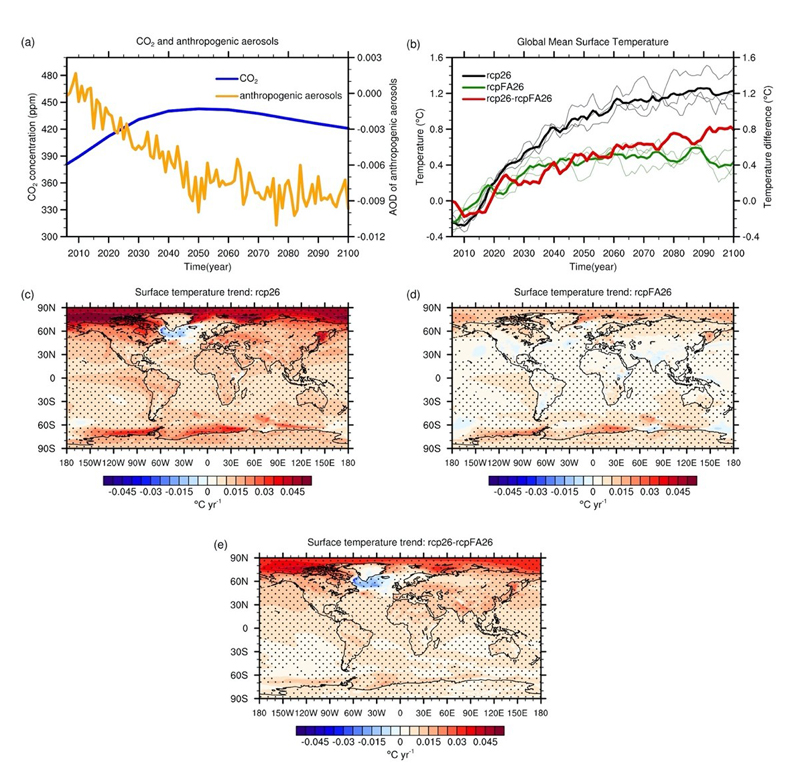中国科学院大气物理研究所大气科学和地球流体力学数值模拟国家重点实验室
State Key Laboratory of Numerical Modeling for Atmospheric Sciences and
Geophysical Fluid Dynamics (LASG)
Institute of Atmospheric Physics, Chinese Academy of Sciences
State Key Laboratory of Numerical Modeling for Atmospheric Sciences and
Geophysical Fluid Dynamics (LASG)
Institute of Atmospheric Physics, Chinese Academy of Sciences

Vol.17/No.17 April 2022
Reductions of Anthropogenic Aerosols under Carbon Neutrality Enlarge Surface Temperature Increase
In response to the 1.5°C/2°C low-warming target of the 2015 Paris Agreement, Chinese government proposed the "carbon neutrality" target in 2020, that is, strive to achieve carbon emission peak by 2030 and carbon neutrality by 2060. Many countries have successively adopted policies and regulations to achieve carbon neutrality in the middle of this century. People have paid more attention to the impact of atmospheric CO2 on surface temperature, but the role of aerosols on the spatiotemporal changes of temperature cannot be ignored.
A large reduction in anthropogenic emissions is needed to achieve carbon neutrality and the low-warming target, which means that the concentration of CO2 and aerosols in the atmosphere will jointly show a downward trend in the future. However, the same trends in aerosols and CO2 will cause the opposite radiative effects. The warming effect produced by reduced aerosols works simultaneously with the cooling effect caused by reduced CO2. In addition, aerosols can also affect the dynamic processes from the surface to the deep layer in the ocean, thereby altering regional features of ocean temperature.

Time series of the contents of CO2 and anthropogenic aerosol in the atmosphere under a low-emission scenario (RCP2.6) (a) and time series of global mean surface temperature (b); Long-term trends of surface temperature in all-forcing simulation (c), fixed-aerosol simulation (d), and the difference between these two simulations (e). (Image by MA Xiaofan)
To explore the impact of future reductions in anthropogenic aerosols on surface temperature, this study used the Community Earth System Model (CESM) to perform fixed-aerosol experiments over the 21st century under a low-emission scenario (RCP2.6) and compared the results with those in all-forcing simulations under the same scenario. They found that the additional warming effect caused by the continued decline of aerosols in the 21st century will make the global mean surface temperature increase for a longer period of time, rather than turn to decrease following the reduction of CO2 (after ~2050).
They also found that under the low-emission scenario, when other regions have long-term warming trends in surface temperature, the subpolar North Atlantic (south of Greenland) shows long-term cooling trends. This phenomenon is dominated by aerosols while CO2 plays a secondary role. The regional inconsistency of temperature changes is mainly due to the weakening of the Atlantic Meridional Overturning Circulation (AMOC). Under the reduction of anthropogenic aerosols, the AMOC continues to weaken since the beginning of the 21st century, which causes the northward heat transport in the Atlantic continue to weaken. The anomalous cold signals gradually accumulate in the subpolar North Atlantic, leading to the significantly cooling trends in sea surface temperatures over this region occur in the second half century. The cooling of the sea surface further induces the local ocean to absorb more heat from the atmosphere through air-sea heat flux.
"Our study indicates that when planning a specific path to achieve carbon neutrality and low-warming targets, it is necessary to consider the important role of anthropogenic aerosols on the climate system", the corresponding author Prof. Huang Gang emphasized. The study was completed by Dr. MA Xiaofan, Prof. HUANG Gang, and Prof. CAO Junji from the Institute of Atmospheric Physics, Chinese Academy of Sciences.
Citation: Xiaofan Ma, Gang Huang, Junji Cao, The significant roles of anthropogenic aerosols on surface temperature under carbon neutrality. Science Bulletin (2021), doi: https://doi.org/10.1016/j.scib.2021.10.022
Link: https://www.sciencedirect.com/science/article/pii/S2095927321006915?via%3Dihub
Contact: HUANG Gang, hg@mail.iap.ac.cn
Add: No.40, Huayanli, Beichen West Road, Chaoyang District, Beijing P.O. Box 9804, 100029, China
E-mail: lasg_newsletter@lasg.iap.ac.cn
Editors: Chuanyi Wang (wangcy@lasg.iap.ac.cn), Kangjun Chen(ckj@lasg.iap.ac.cn)
E-mail: lasg_newsletter@lasg.iap.ac.cn
Editors: Chuanyi Wang (wangcy@lasg.iap.ac.cn), Kangjun Chen(ckj@lasg.iap.ac.cn)